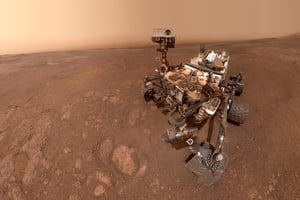In a recent post from NASA, new analysis of data from the Mars rover, Curiosity, suggests a need to reconsider the processes leading to the formation of Mount Sharp.
The basic principles of geology were laid out in a paper published 350 years ago by Nikolas Steno. As explained in this article, these principles were contrary to the geological understanding of the time.
Currently, for planet Earth, the formation of mountains is usually explained using the theory of plate tectonics. Geological processes that form mountains on Mars, however, may be quite different. Rather than plate tectonics, the landscape of Mars is usually explained by the action of wind and sand erosion. This is one explanation offered for the existence of Mount Sharp in the Gale crater.
 Mount Sharp, inside Gale Crater, Mars / Image credit: NASA/JPL-Caltech/ESA/DLR/FU Berlin/MSSS
Mount Sharp, inside Gale Crater, Mars / Image credit: NASA/JPL-Caltech/ESA/DLR/FU Berlin/MSSS
Scientists have been somewhat mystified however, because the peak of Mount Sharp is higher than the rim of the crater. The following explanation found in the NASA post is a good example of how scientists have tried to explain its formation:
The Gale Crater was once filled to the brim with sediment which would have compressed the rock layers beneath it; after millions of years of wind and sand erosion, Mount Sharp was left behind with debris piling up on top as winds continued to sweep across the surface of Mars.
If this theory were true, then one would expect that the rock layers would be extremely dense since, according to this theory, they were compressed by several miles of sediment leaving no room for air pockets.
It turns out however that this is not the case. The rocks are surprisingly more porous than expected, which means there can’t have been that much material piled on top of it.
Science in motion
Two details make this story a good example of science in action.
- Creative minds went to work on data generated for an entirely different purpose. The density of the rocks can be determined using gravimetry. Gravimetry is the precise measurement of gravitational fields and has been used to study the internal structure of the Earth and other planets. For example, the Apollo 17 crew collected such measurements on the moon using a gravimeter. Prior to the 2012 landing of the Mars rover, Curiosity, gravitational field measurements for Mars were only available using data from satellites in orbit. Surface measurements of gravity provide more accurate information, but Curiosity does not have this specific instrument. This fact did not stop a team of researchers led by Kevin Lewis from John Hopkins University. They used data from the accelerometer and gyroscope on board—which enabled Curiosity to navigate over the Martian terrain. In this recently published study, 700 measurements of accelerometer data were converted to gravitational data. In combination with data from the chemistry and mineral instrument, this information was used to determine the density of the sedimentary layers at the base of Mount Sharp. Data is just data without the insights generated and integrated by the creative intelligence of a human person.
- Creative minds went to work on integrating new data, comparing it against prior assumptions and previous less precise data. As mentioned above, that the rock is more porous than expected puts a limit to the probable depth of sediment that covered these layers, calling into question the proposed explanation that the crater had been filled to its 3 mile brim. So it’s back to work on a new explanation for the formation of Mount Sharp as scientists eagerly wait for more data from the explorations of the Curiosity rover.
This is how science works.
Our understanding of the universe expands as the increasing precision of technology generates new information and as creative minds scrutinize the data, integrating it within a widening horizon of insights into the workings of the incredible universe we call home.
Feature image credit: ASA’s Curiosity Mars rover / NASA/JPL-Caltech/MSSS
Read next:
The Galactic Recipe for a Living Planet [Video]

